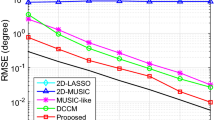Abstract
This paper discusses the problem of the direction of departure (DOD) and the direction of arrival (DOA) estimation for multi-input multi-output (MIMO) radar with array gain-phase errors. In this paper, we propose a propagator method (PM)-like algorithm for joint angle and array gain-phase errors estimation in MIMO radar. The proposed method not only yields automatically paired estimates of the angles and gain-phase errors but also has much better gain-phase errors estimation performance than the estimation of signal parameters via rotational invariance techniques (ESPRIT)-like algorithm; this has higher computational cost than the proposed algorithm. Furthermore, the proposed algorithm has angle estimation performance very close to ESPRIT-like algorithm. We also derive the Cramér–Rao bound (CRB) for MIMO radar with array gain-phase errors. Simulation results present the usefulness of our approach.


















Similar content being viewed by others
References
J.L. Chen, H. Gu, W.M. Su, A new method for joint DOD and DOA estimation in bistatic MIMO radar. IEEE Trans. Signal Process. 90(2), 714–718 (2010)
A. Di, Multiple sources location—a matrix decomposition approach. IEEE Trans. Acoust. Speech Signal Process. 35(4), 1086–1091 (1985)
C. Duofang, C. Baixiao, Q. Guodong, Angle estimation using ESPRIT in MIMO radar. Electron. Lett. 44(12), 770–771 (2008)
X. Gao, X.F. Zhang, G.P. Feng et al., On the MUSIC-derived approaches of angle estimation for bistatic MIMO radar, in International Conference on Wireless Networks and Information Systems, Shanghai, 28–29 Dec. 2009, pp. 343–346
Y.D. Guo, Y.S. Zhang, N.N. Tong, ESPRIT-like angle estimation for bistatic MIMO radar with gain and phase uncertainties. Electron. Lett. 47(17), 996–997 (2011)
A.M. Haimovich, R.S. Blum, L.J. Cimini, MIMO radar with widely separated antennas. IEEE Trans. Signal Process. 25(1), 116–129 (2008)
M. Jin, G.S. Liao, J. Li, Joint DOD and DOA estimation for bistatic MIMO radar. IEEE Trans. Signal Process. 89(2), 244–251 (2009)
A. Li, S. Wang, Propagator method for DOA estimation using fourth-order cumulant, in International Conference on Wireless Communications, Networking and Mobile Computing, Wuhan, 23–25 Sept. 2011, pp. 1–4
J. Li, P. Stoica, MIMO radar—diversity means superiority, in Proc. 14th Adaptive Sensor Array Process Workshop (ASAP’06), Lincoln Lab, Mass, USA (2006), pp. 2–6
T.J. Shan, On smoothed rank profile tests in eigenstructure methods for directions-of-arrival estimation. IEEE Trans. Acoust. Speech Signal Process. 35(10), 1377–1385 (1987)
P. Stoica, A. Nehorai, Performance study of conditional and unconditional direction-of-arrival estimation. IEEE Trans. Signal Process. 38(10), 1783–1795 (1990)
M. Sylvie, M. Alain, B. Messaoud, The propagator method for source bearing estimation. IEEE Trans. Signal Process. 42(1), 121–138 (1995)
B.H. Wang, Y.L. Wang, H. Chen et al., Array calibration of angularly dependent gain and phase uncertainties with carry-on instrumental sensors, in IEEE International Symposium on Phased Array Systems and Technology, 14–17 Oct. 2003, pp. 182–186
M. Wax, Detection of the number of coherent signals by the MDL principle. IEEE Trans. Acoust. Speech Signal Process. 37(8), 1190–1196 (1989)
H.T. Wu, Source number estimator using Gerschgorin disks, in IEEE International Conference on Acoustics, Speech, and Signal Processing, Adelaide, SA 19–22 Apr. 1994, pp. 261–264, vol.4
A. Zahernia, M.J. Dehghani, R. Javidan, MUSIC algorithm for DOA estimation using MIMO arrays, in International Conference on Telecommunication Systems, Services, and Applications, Bali, 20–21 Oct. 2011, pp. 149–153
X.D. Zhang, Matrix Analysis and Applications (Tsinghua University Press, Beijing, 2004), pp. 107–111
X.F. Zhang, Z.Y. Xu, L.Y. Xu et al., Trilinear decomposition-based transmit angle and receive angle estimation for MIMO radar. IET Radar Sonar Navig. 5(6), 626–631 (2011)
Z.D. Zheng, J.Y. Zhang, Fast method for multi-target localization in bistatic MIMO radar. Electron. Lett. 47(2), 138–139 (2011)
Acknowledgements
This work is supported by China NSF Grants (60801052), Jiangsu Planned Projects for Postdoctoral Research Funds (1201039C), Open project of key laboratory of underwater acoustic communication and marine information technology (Xiamen University) and the Fundamental Research Funds for the Central Universities (NZ2012010, kfjj120115, kfjj20110215).
Author information
Authors and Affiliations
Corresponding author
Rights and permissions
About this article
Cite this article
Chen, C., Zhang, X. Joint Angle and Array Gain-Phase Errors Estimation Using PM-like Algorithm for Bistatic MIMO Radar. Circuits Syst Signal Process 32, 1293–1311 (2013). https://doi.org/10.1007/s00034-012-9502-2
Received:
Revised:
Published:
Issue Date:
DOI: https://doi.org/10.1007/s00034-012-9502-2




